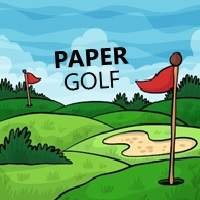
The Paper Golf Game
Paper Golf is a passive and competitive recreational game to inspire creativity and practice intuition in pairs or small groups.
Hand out a sheet of paper, the larger the better, for each person. Then, using a sheet of paper in front of you to demonstrate, explain that you would like everyone to design their own golf course.
I suggest designing a paper golf course with just three holes, but there’s no magic in this number. Just be sure to add tees, fairways, greens and holes with little flags poking out of them.
Design a few challenging hazards such as lakes, streams, and sand bunkers. Allow several minutes for the creative process.
Now, how to play. As per regular golf, each person aims to record as few ‘strokes’ as possible in their game.
With pen in hand, start by placing the tip of your pen on the first tee. Close your eyes, and then move or drag the pen across the paper (so that it marks a line,) stopping whenever you feel necessary (such as to avoid a water hole, or running off the paper).
When finished, open your eyes, and record this as your first stroke. The next stroke starts from the end of the ink line of the preceding stroke.
Although each golf course designer may implement their own rules, the general idea is to avoid hitting or crossing your pen over any of the drawn obstacles.
Play continues until the end of a single stroke (ink line) lands directly in the middle of the first hole. Crossing over or skimming the edge of the hole doesn’t count, the pen must land right in the middle of it.
In the same golf course there can be two or more players playing. When all players have completed all holes, add the total number of strokes (lines) taken, and the person with the lowest score wins.
Play next game on partner’s golf course, or continue play with any other person.
At the end, allow people to say how it felt to move the pens. Could you guess the obstacle areas like lakes or sandbanks? Was it difficult to hit the center of each hole? What strategy did you use to move the pen?
The topics of this publication: interactions, integration, disinhibition, distension


